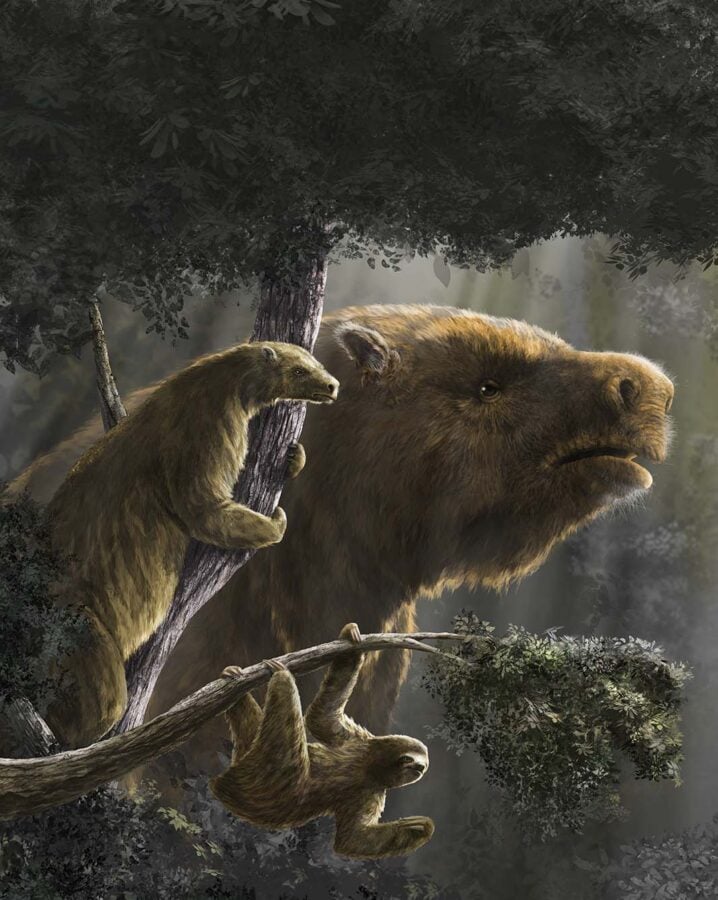Elephant-sized sloths once roamed from Alaska to Argentina, carving caves with massive claws and diving into oceans for seagrass meals.
These ancient giants, some weighing 8,000 pounds, dominated the Americas for over 30 million years before vanishing around 15,000 years ago—just as humans spread across the continents. A new study published in Science reveals how these remarkable creatures evolved their enormous sizes and why they disappeared so suddenly, painting a picture of an ecological catastrophe that reduced one of evolution’s most successful mammal groups to just six small tree-dwelling species.
From Tree Huggers to Ground Giants
The research, analyzing over 400 fossils from 17 museums and ancient DNA, shows that giant size wasn’t the original sloth blueprint. The earliest sloths were likely terrestrial creatures about the size of a Great Dane, but their evolutionary journey took dramatic turns based on where they lived.
“They looked like grizzly bears but five times larger,” said Rachel Narducci, collection manager of vertebrate paleontology at the Florida Museum of Natural History and study co-author, describing the massive Megatherium genus.
Trees imposed strict weight limits then as they do now. Modern tree sloths average just 14 pounds, while their semi-terrestrial cousins averaged 174 pounds. Ground-dwelling species faced no such constraints, eventually reaching sizes that dwarfed modern elephants.
Climate Drove the Size Revolution
The study reveals that sloth size evolution closely tracked climate changes over 35 million years. During the warm Middle Miocene period (17-14 million years ago), sloths actually got smaller as expanding forests favored arboreal lifestyles.
But as Earth cooled, ground sloths bulked up dramatically. Larger bodies helped them conserve energy and water while traveling across diverse habitats—from Andean peaks to Arctic forests to ocean shores.
Some sloths even adapted to marine environments. “They developed adaptations similar to those of manatees,” Narducci explained. “They had dense ribs to help with buoyancy and longer snouts for eating seagrass.”
Key Evolutionary Patterns:
- Terrestrial sloths averaged 758.6 kg (1,672 lbs) at optimal size
- Arboreal species maxed out at 6.5 kg (14 lbs) on average
- Gigantism evolved independently three times in different lineages
- Size changes correlated strongly with habitat preferences over 35 million years
- Evolutionary rates were faster in tree-dwelling species
Masters of Their Environment
Ground sloths weren’t just big—they were incredibly diverse. They climbed mountains, crossed deserts, and even made homes in boreal forests stretching into modern-day Canada and Alaska. Their impressive claws, “among the largest of any known mammal, living or extinct,” allowed them to excavate elaborate cave systems.
These caves served multiple purposes, from shelter to bathrooms. In 1936, paleontologists discovered a 20-foot-thick mound of fossilized sloth droppings in Nevada’s Rampart Cave—a testament to their long-term occupancy of favored sites.
The Florida Museum houses “the largest collection of North American and Caribbean-island sloths in the world,” according to Narducci, who personally measured 117 fossil limb bones for the study.
The Human Factor
What caused such successful creatures to vanish so abruptly? The timing tells a stark story. “About 15,000 years ago is when you really start to see the drop-off,” Narducci noted.
This coincides precisely with human expansion across the Americas. While climate continued changing, the study found no correlation between temperature shifts and sloth extinctions during their final 130,000 years.
The very size that protected giant sloths from natural predators became their downfall. Neither fast nor well-defended against human hunters, ground sloths were “easy pickings for early humans,” as the evidence suggests.
Even tree sloths weren’t entirely safe. Caribbean island species survived until about 4,500 years ago—vanishing shortly after humans arrived in the region.
What We Lost
The sloth extinction represents more than the loss of charismatic megafauna. These creatures filled ecological roles that no modern animals can replicate. Giant ground sloths acted as ecosystem engineers, dispersing seeds, maintaining grasslands, and creating habitat modifications that supported countless other species.
“Including all of these factors and running them through evolutionary models with multiple different scenarios was a major undertaking that had not been done before,” Narducci said of the comprehensive analysis.
Today’s six sloth species—all small and arboreal—survived likely because they lived in dense, inaccessible forest canopies where early humans rarely ventured. But they represent just a tiny fraction of sloth diversity that once flourished across two continents.
The study serves as a sobering reminder of how quickly human arrival can reshape entire ecosystems. In just a few thousand years, one of evolution’s most successful experiments in mammalian gigantism was reduced to a handful of sleepy tree-dwellers—living monuments to a lost world of giants.
Discover more from Wild Science
Subscribe to get the latest posts sent to your email.

